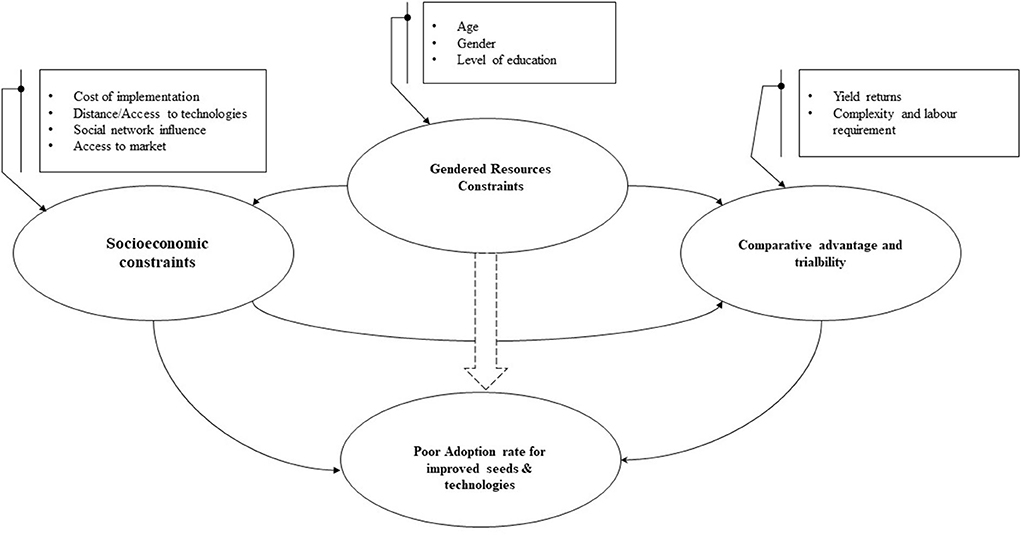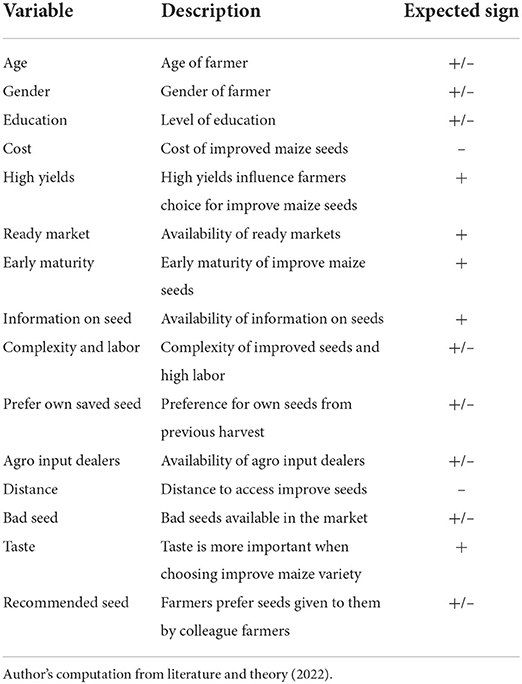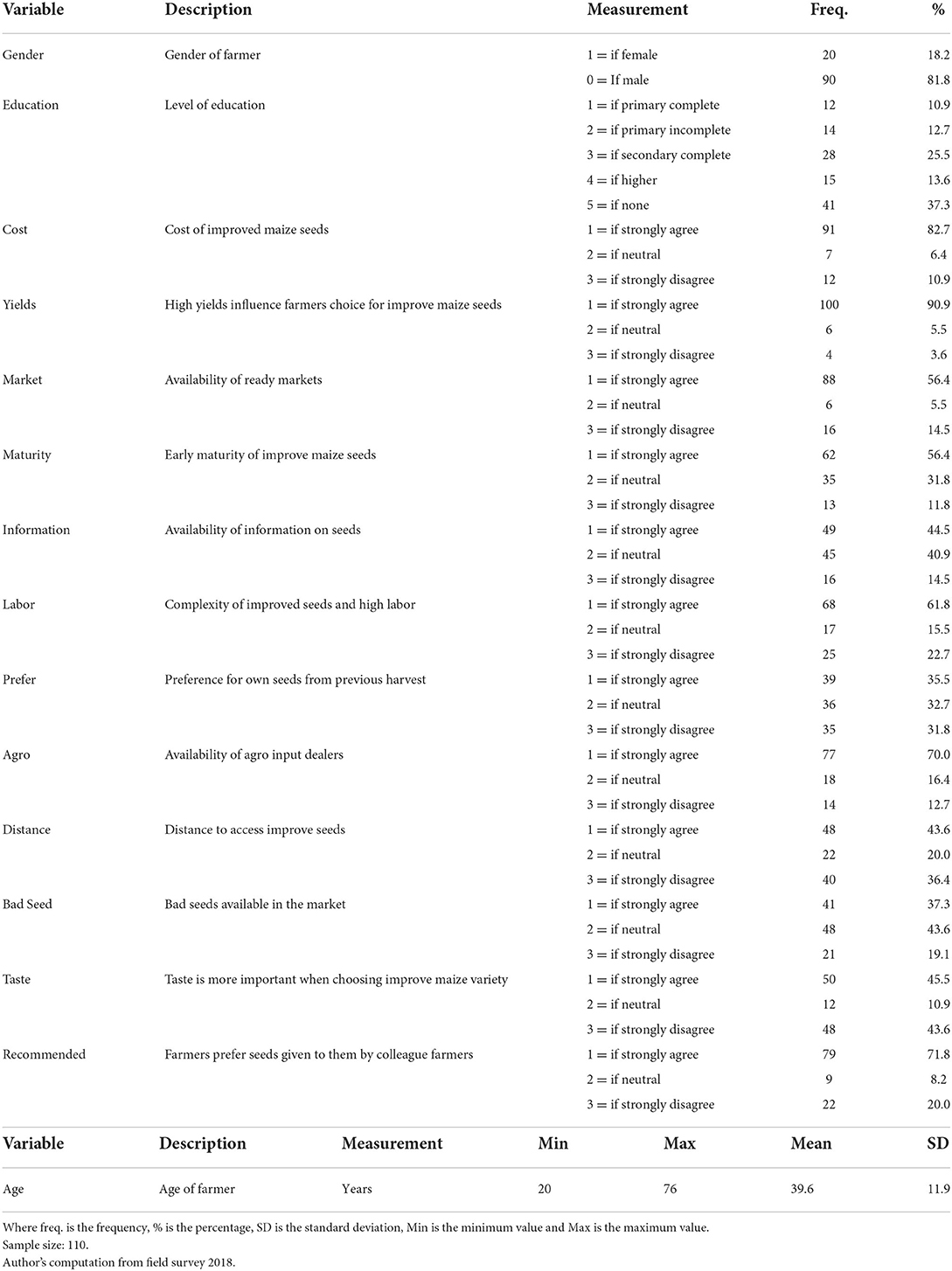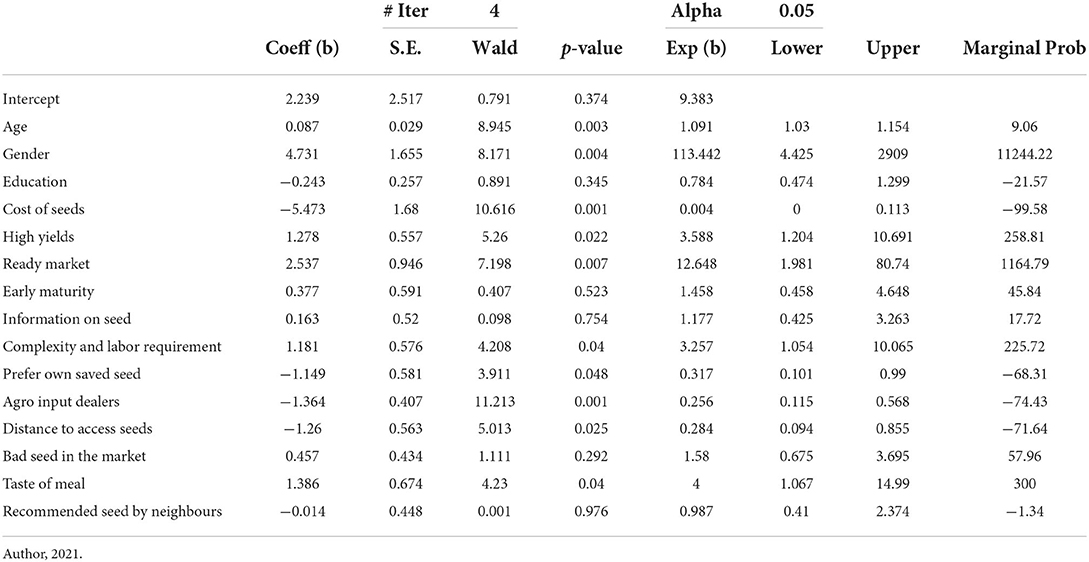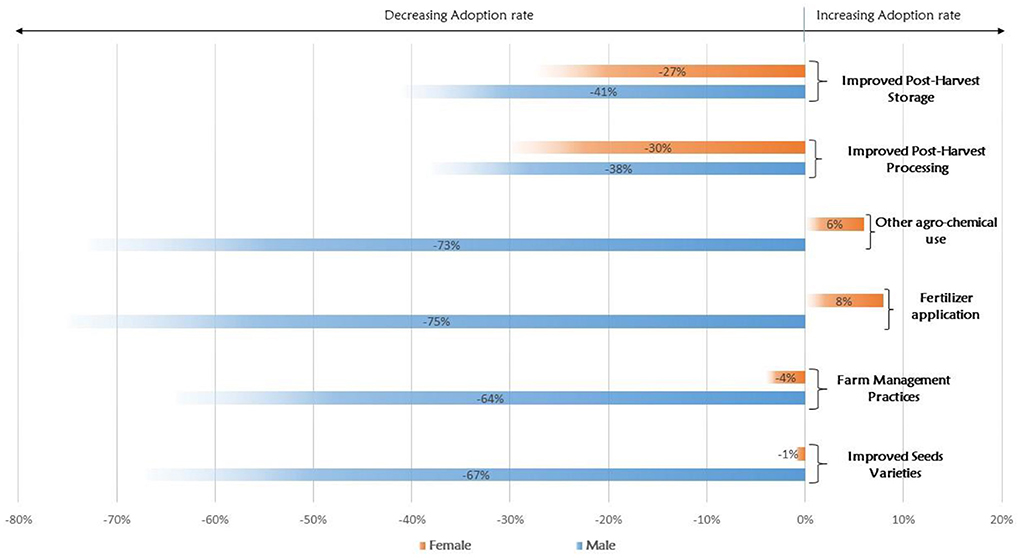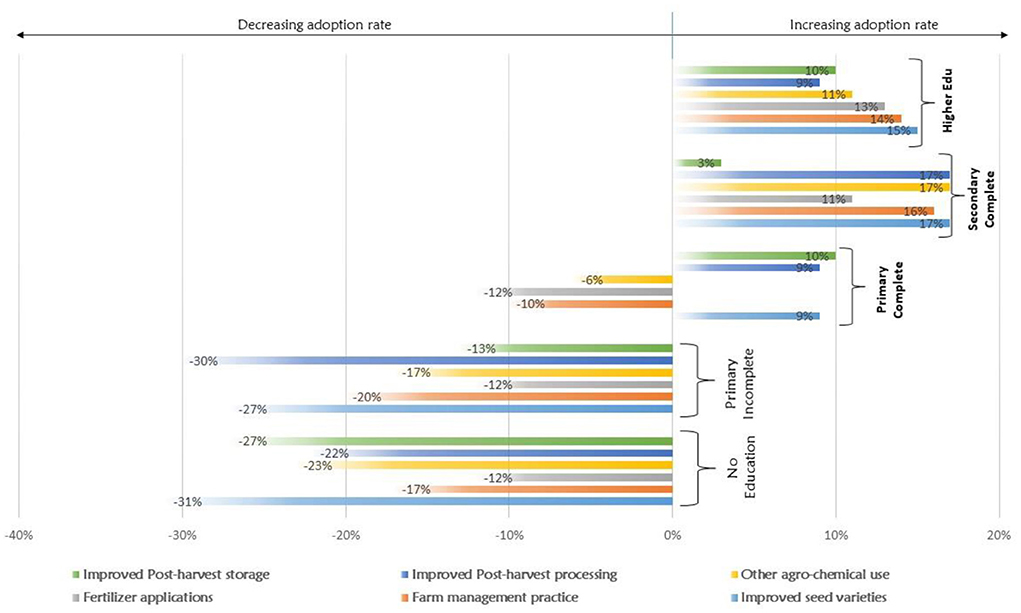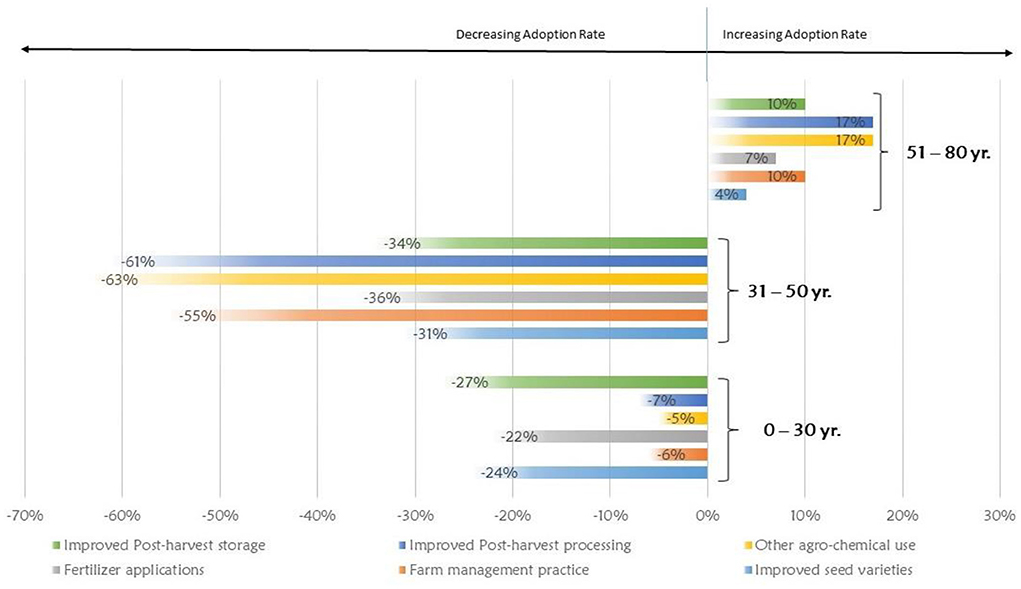- 1School of Governance and Public Services, Ghana Institute of Management and Public Administration, Accra, Ghana
- 2Department of Geography, Environment and Geomatics, University of Guelph, Guelph, ON, Canada
- 3Guelph Institute of Development Studies, University of Guelph, Guelph, ON, Canada
- 4Global Agri-Business Solutions INC, Brantford, ON, Canada
- 5Department of Environmental Science, Kwame Nkrumah University of Science and Technology, Kumasi, Ghana
- 6Graduate School of Natural and Applied Sciences, Department of Agricultural Economics, Ege University, Izmir, Turkey
- 7Alliance for Sustainable Development, Buea, Cameroon
- 8Arrell Food Institute, University of Guelph, Guelph, ON, Canada
Amidst the COVID-19 pandemic, the need to accelerate food production efforts to achieve the UN SDG two, i. e., zero hunger target by 2030, is gaining momentum across the global food security discourse. One way to accelerate food production is to adopt improved seeds and technologies that may close existing yield gaps and support food security efforts in regions such as Sub-Saharan Africa. This paper uses mixed methods, including key informant interviews, structured household questionnaire surveys and focus group discussions, to examine the factors influencing the adoption of improved seeds and complementing technologies in Ghana. In particular, we draw insight from theories of failed market-induced behavior, innovation diffusion and induced-innovation theories to explore farmers' perceptions and adoption of different specific improved maize varieties and technologies for agricultural productivity. Our findings suggest that the level of awareness of improved seeds, particularly hybrid seeds and technologies, and the adoption rate of these technologies are low among Ghana's rural farmers. The findings reveal that socio-demographic and economic factors such as gender, age, cost of seeds, the promise of more yields, market access, social networks' influence, seed availability and accessibility are essential determinants of adopting improved planting technologies among smallholder farmers. This paper argues that location and context-specific-targeted extension services delivery to enhance the widespread adoption of improved seeds and technologies across scales can build farmers' capacity to increase agricultural productivity.
Introduction
The need to increase food production using improved technologies to avert possible post-COVID-19 food crises, especially in regions that experience food production shortfalls, is echoed in the global food security discourse (Ayanlade and Radeny, 2020; Ojiewo and Pillandi, 2020; Preneuf, 2020). Although some scholars argue that the African food system is less vulnerable to the COVID-19 disease due to its late arrival on the continent (Moseley and Battersby, 2020), others note that the locked-down (partial and total) measures put in place by nations of Sub-Saharan Africa (SSA) to curb the spread of the virus interrupted with the planting and harvesting seasons of most staple crops in the region (Ayanlade and Radeny, 2020). According to experts, this situation has culminated in low food production, enmeshed within other COVID-19 crises such as loss of livelihoods due to the shutdown, high food prices, and other issues in the region. To subjugate this food insecurity situation is the multi-scaler and multi-sectoral United Nations Sustainable Development Goals (SDG)-−2 Zero Hunger target by 2030, which aim to support smallholders by increasing their productivity through access to agricultural inputs such as improved planting materials and technologies (Araya et al., 2015; Agarwal, 2018; UN-FAO., 2021; UN Stats, 2021). Remarkably, is the potential embedded within achieving SDG-−5 Gender Equality target via female smallholders' equal access to agricultural resources such as lands, improved seeds and technologies to address issues of global food insecurity (Araya et al., 2015; Agarwal, 2018).
The FAO suggested that support for agricultural production (e.g., seeds distribution) to small-scale farmers is essential to reduce the impact of the post-COVID-19 pandemic on the already vulnerable households in Sub-Saharan Africa (FAO, 2020). Indeed, some scholars have argued that the ability of the region's smallholder farmers to access and adopt improved technologies, particularly hybrid seeds, is the catalyst for agricultural transformation, increased productivity, and closing the already existing crop yield gaps (Foley et al., 2011), and to reclaim Africa's food security, economic growth and development [Alliance for a Green Revolution in Africa (AGRA), 2018]. For instance, the adoption of enhanced maize cultivars in Nigeria boosted maize grain yield by 574 kg/ha and total per-capita expenditure by US$77 (US$0.21/day). Overall, the study indicated that without the adoption of the enhanced seed varieties, the rate of poverty among adopters would have increased by 6% (Abdoulaye et al., 2018). Therefore, agricultural productivity via the adoption of improved seed varieties in key staple crops is a sine qua non to achieving Africa's food security and reducing the food import bill, which currently stands at US$35–50 billion annually (Gakpo, 2020). At the national level, Ghana's food import bill is US$2 billion and is projected to increase in the following decades (Bloomberg Market, 2017; Ghana National Daily Graphic, 2018).
Making improved seeds and technology available to farmers does not automatically translate into high adoption (Langyintuo et al., 2010; Gassner et al., 2019). Therefore, this paper examines the level of awareness and adoption of hybrid maize seeds [Supplementary Sheet A and complementing technologies among farmers in Ghana, whose livelihoods are threatened by climatic and non-climatic stressors (Antwi-Agyei et al., 2017)]. The specific objectives of the study are to: (1) Assess the level of awareness of smallholder farmers on improved maize seeds in Ejura Sekyeredumase Municipality in terms of; (2) Assess the adoption rate of improved maize seeds and associated technologies and (3) Assess the factors that determine the adoption of improved maize seeds by smallholder farmers. This paper is divided into six sections; (1) Background Context and Theoretical Framework, (1) Research Settings, Design and Methods, (3) Study Result, (4) Discussion, (5) Policy Focus and Recommendations, and (6) Conclusion. The choice for maize and, in particular, Ghana is because maize is the fastest-growing staple food crop in SSA, widely accepted as the primary food security crop in Africa and doubles as the major source of income for food producers on the continent (Smale and Mason, 2014; Ayanlade and Radeny, 2020).
For more insight on the decision to focus this research on the maize crop and, in particular, Ghana, the history of seed development and commercialization in Ghana within the broad strategy of the new green revolution envisioned for Africa, refer to the first part of this important research published—the Africa “seeds” revolution and value chain constraints to Early Generation Seeds (EGS) commercialization and adoption in Ghana (Quarshie et al., 2021).
The adoption of improved technologies among smallholder farmers has been studied extensively in SSA, using theories of innovation diffusion (Adesina and Baidu-Forson, 1995; Caswell et al., 2001; Adeogun et al., 2010; Buah et al., 2011), induced innovation theories (Doss and Morris, 2001; Adeogun et al., 2010; Atilaw et al., 2016; Ainissyifa et al., 2018), and the theory of failed-market induced behavior (Amadu et al., 2020; Teye and Quarshie, 2021). To the best of our knowledge, these three theories were used in isolation from each other except for Amadu et al. (2020). They used the theory of innovation diffusion and the theory of failed market induced-behavior to understand the adoption rate of climate-smart technologies among Africa's rural farmers. Likewise, Teye and Quarshie (2021) used Rogers' innovation theory and Failed-market induced behavior to study the impact of agriculture loans on improved rice technologies adoption in Ghana. This paper, therefore, advances our understanding of how these three theories help shape our perception of the specific factors influencing technology adoption among rural farmers in SSA. We demonstrate how technology adoption among smallholder farmers can be understood when examined within three broad theories; Failed-market induced behavior (De Janvry and Sadoulet, 2006; Amadu et al., 2020), theories of innovation diffusion (Rogers, 2003) and induced innovation theory (Ruttan and Hayami, 1984).
The paper contributes to the growing body of literature on gender and technology adoption, such as those published earlier (e.g., Doss and Morris, 2001; Ragasa, 2012; Ndiritu et al., 2014; Gebre et al., 2019; Tsige et al., 2020; Asante et al., 2021).
This study adds to the existing literature by using data obtained from field-level surveys among smallholder farmers in Ghana to assess patterns and determinants of modern technology adoption. Secondly, we apply statistical methods to estimate the specific adoption rate for specific hybrid maize crop varieties recently released and commercialized in Ghana and their complementing technologies. Moreover, we rely on this estimation to explore the gender, age group and year of education of smallholder farmers adopting particular improved technologies and why such trends exist. Again, the study contributes to the literature by assessing the determinant of modern technology adoption within rapidly environmental and socioeconomic conditions. Finally, we argue these contributions are all significant in understanding gender-specific needs, place and context-specific characteristics of technology adoption among rural farmers. Such vital information is critical for formulating gender-specific policies to enhance the widespread adoption of hybrid seeds within the broad strategy of the new green revolution in Africa. Lastly, gender-specific characteristics in technology adoption will assist in addressing the issue of gender inequality in access to agricultural technologies, food security, rural livelihood improvement and ultimately sustainable food systems across the scale.
Background context and literature review
Constraints to agricultural productivity in Sub-Saharan Africa
Agricultural productivity in SSA suffers numerous constraints, with one key issue being access to and utilization of improved seeds and technologies (Dixon et al., 2001; Afful-Koomson et al., 2015). Access to improved seeds, mainly hybrid and effective extension services, is among the most basic agricultural production requirements that lead to farmers' sustainable livelihood (Langyintuo et al., 2010; Muzari et al., 2012). Unlike open-pollinated seeds (OPVs), hybrids have about 20–25% yield potential than OPVs (FAO, 2014, 2017; CIMMYT, 2020). In most countries, such as the USA, they have up to 100% yield potential than OPVs (Kutka, 2011) and can withstand most biophysical stresses. Studies have shown that SSA farmers prefer OPVs because they could be saved for replanting, whereas fresh hybrid seeds must be purchased for planting every season (Ragasa et al., 2013; Monela, 2014), making smallholding agriculture input-dependent and indebtedness to smallholder farmers (Moseley et al., 2015; Vercillo et al., 2020). Although the adoption rate of hybrid seeds among smallholders in West Africa is low, the story is perceived differently in Eastern and Southern African States, which have an approximate adoption rate of 33% and 38%, respectively (Langyintuo et al., 2010). In Ghana, the government's ministry of agriculture estimates the adoption rate of improved seeds among rural farmers is around 10% (MoFA, 2015), with only 1–8% of farmers noted to be adopting hybrid seeds (Azinu, 2014; Nyantakyi-Frimpong and Bezner Kerr, 2015). However, some studies suggest these figures are promising due to the government's Planting for Food and Jobs (PFJ) initiative, which seeks to enhance smallholder farmers access to improved seeds, technologies and extension services delivery to accelerate Ghana's agricultural transformation [MoFA–Statistics, Research and Information Directorate (SRID), 2016].
For instance, some researchers suggest drought tolerance maize (DTM) adoption in Ghana is 82% (Martey et al., 2020). However, a critical missing component from this study is that the authors never mentioned which type of improved maize seeds, i.e., which OPVs or Hybrid maize seeds, recorded that adoption rate since most OPVs and Hybrid maize seeds are considered DTM variety. In sharp contrast to Martey et al. (2020) findings, another research study conducted from a six-months of ethnographic emersion in Northern Ghana suggests smallholder farmers are reluctantly adopting improved seeds and other technologies (Vercillo et al., 2020), with the hybrid seeds adoption rate standing at 8% (Nyantakyi-Frimpong and Bezner Kerr, 2015). A regional study that included 13 maize-producing nations in SSA, including those in West Africa, East Africa, and Southern Africa, found that the 2013/2014 major crop season saw the cultivation of ~500 maize cultivars. Of all cultivars, about 32% were hybrids, 23% were enhanced open-pollinated varieties (OPVs), and 46% were traditional or farmer-saved seeds (Abate et al., 2017). According to Nyantakyi-Frimpong and Bezner Kerr (2015), the use of hybrid seeds among smallholder farmers erodes their agency to solve the day-to-day farm problems, thereby interfering with smallholders' sense of place within a rapidly changing environmental and socioeconomic condition (see, also Quarshie, 2021). Furthermore, recent studies by Teye and Quarshie (2021) suggest that even farmers who are willing to adopt these technologies do not have access to credit instruments from banks and other financial institutions because they do not trust them. The poor adoption rate of improved maize seeds and complementing technologies before, during, and post-COVID-19 pandemic is likely to stall efforts to address poor agricultural productivity and exacerbate ongoing COVID-19 pandemic-induced food insecurity among rural households.
Theoretical framework
The theoretical framework underpinning this technology adoption research are; failed market-induced behavior (De Janvry and Sadoulet, 2006; Amadu et al., 2020), theories of innovation diffusion (Rogers, 2003) and induced innovation theory (Ruttan and Hayami, 1984). According to Rogers (2003), key innovation features, such as its comparative advantage over existing technologies, including the cost involved to adopt them and its trialbility, influence the adoption rate. Furthermore, Dosi (1992) expounded on innovation diffusion theory to capture information about the level of awareness of a particular technology and competence to use a particular technology as evolutionary factors that influence the technology adoption rate. Induced innovation is when technological change is directed towards saving more of the scarce or more expensive production input factors per unit of output at constant prices (Just et al., 1979; Ruttan and Hayami, 1984). Research has expanded the theory to capture broad themes of how resource endowment of end-users (ibid), particularly gender differentials in resource access (Doss, 2013), end-users age (Adesina and Baidu-Forson, 1995; Adeogun et al., 2010), adoptors' level of education (Caswell et al., 2001; Buah et al., 2011), cascading with failed-market characteristics such as the high transactional cost, absence of capital and labor, influences improved technologies adoption rate (De Janvry and Sadoulet, 2006; Amadu et al., 2020). These theories have been used extensively to understand determinants of technology adoption among SSA rural farmers (e.g., Adesina and Baidu-Forson, 1995; Adeogun et al., 2010; Atilaw et al., 2016) (see Figure 1).
Determinants of improved seeds adoption in Sub-Saharan Africa
Current research on improved seeds and technologies adoption suggests in addition to institutional barriers such as seeds value chain constraints (Quarshie et al., 2021) and the enduring intensification dilemma to adopt or not adopt improved technologies (Quarshie and Abdulai, 2021), other socioeconomic and agroecological barriers (Cavane and Donovan, 2011; Ainissyifa et al., 2018) influence farmers' decisions to adopt improved seeds in SSA. For instance, SSA smallholders are a diverse and heterogeneous group (Gassner et al., 2019) scattered across different agroecological zones and farming systems (Garrity et al., 2017), each with different incentives, resources and aspirations to adopt improved technologies (Mausch et al., 2018; Gassner et al., 2019). Some of the factors that constraints smallholders' effort to adopt improved technologies are; financial constraints [Atilaw et al., 2016; Alliance for a Green Revolution in Africa (AGRA), 2018], farmers' age (Adesina and Baidu-Forson, 1995; Adeogun et al., 2010), and farmers' education level (Caswell et al., 2001; Buah et al., 2011). Answering the question of farmers' gender being a determinant of technology adoption in SSA, some argued that “technology adoption decisions depend primarily on access to resources, rather than on gender per se” (Doss and Morris, 2001, p.39).
The influence of farmers' age on technology adoption in SSA is fiercely contested on multiple fronts. For instance, other researchers suggest older farmers are assumed to have gained more experience and knowledge with time and, therefore, can shoulder much more risk in adopting new planting technologies than younger farmers (Mignouna et al., 2011; Asante et al., 2014). Some also argue the new digital revolution, which heralds the smart-technologies landscape in SSA, is appealing to younger farmers and hence the high rate of technology adoption among them compared to older farmers (Adesina and Baidu-Forson, 1995; Ogada et al., 2014; Uduji and Okolo-Obasi, 2018). Likewise, researchers noted a high probability of technology adoption among smallholder farmers with a higher number of years of schooling compared to those with few years of formal education due to the complexity and analytical skills required to use most improved technologies (Dontsop Nguezet et al., 2013; Gao et al., 2018).
There is also a growing body of literature that suggests that the adoption rate of improved agricultural technologies between men and women is not uniform (e.g., Peterman et al., 2010; Ragasa, 2012; Croppenstedt et al., 2013; Gichuki and Mulu-Mutuku, 2018; Gebre et al., 2019; Asante et al., 2021). Some suggest that the adoption rate remains low among women smallholders, which is influenced by many factors (Doss and Morris, 2001; Ragasa, 2012; Tsige et al., 2020). For instance, in Ethiopia, the adoption of improved maize varieties was low among women-headed households compared to men. These resulted from differences in access to production factors such as lands, extension services, and credits (Gebre et al., 2019). Improved planting technologies adoption rate is high among women in communities where women dominate agriculture and food production (Uaiene et al., 2009) and also where more people are living in their households (Tanellari et al., 2014). According to Nyantakyi-Frimpong and Bezner Kerr (2015), for most female-headed family; the decision to adopt any improved seeds and technologies oscillate around crop characteristics such as yields stability, early maturity, pest, disease and drought tolerance, early maturity; economic factors such as cost of seeds and labor intensity in farm production and post-harvest processes, including flour-to-grain ratio; and culinary characteristics such as the taste of meal prepared with grains cultivated with improved maize seeds.
Therefore, “there is a need to distinguish between women and men when studying adoption or designing policies to promote adoption of agricultural technologies” (Rola-Rubzen et al., 2020, pp.119) since both genders are endowed differently with resources to adopt improved technologies and experience different constraints to adopt modern technologies required to catalyze agriculture productivity and rural household economic wellbeing (Agarwal, 2013, 2018). According to the literature, promoting gender equality in access to agricultural resources under SGD 5 target is critical for achieving SDG 2 Zero Hunger target (Araya et al., 2015; Agarwal, 2018). Ostensibly, SSA has a vast potential to expand maize production due to the availability of suitable land areas for maize production (Smale and Mason, 2014), through the use of well-adapted improved varieties (chiefly hybrids), with accompanying yield-enhancing technologies (KC et al., 2018). However, this review shows gaps in the specific factors that enhance or militate against the adoption of improved technologies by smallholder farmers, as in Ghana's case. Since the adoption of improved technologies is vital to spurring agricultural productivity, there is, therefore, the need to understand barriers constraining smallholders' efforts to adopt hybrid seeds and complementary technologies essential to increasing farm productivity, tackle possible post-COVID-19 pandemic induced-food insecurity and catalyzing efforts to achieve SDG zero hunger target among rural households.
Data and methods
Research design and selection of research sites
This research was a part of a comprehensive study undertaken to investigate the factors that enhance or militate the adoption of hybrid maize seeds and technologies in Ghana. It also forms part of the more extensive research program, which seeks to understand how climate-smart agriculture technologies (in this instance, improved seeds and complementing planting technologies) promote sustainable food system outcomes for rural farmers. The study used a case study of the Ejura Sekyeredumase Municipality (Figure 2). The municipality comprises about 20 communities, with a total population estimated at around 85,446 in 2010. Males constitute 50.20%, while females make up the remaining 49.8%. Agriculture is a significant livelihood activity in the area, as about 60.20% of the populace participate in some form of the sector (Ghana Statistical Services (GSS), 2014). With bimodal rainfall patterns and high humidity (GMet, 2016), the municipality is celebrated as the highest maize-producing area in the Ashanti Region [MoFA–Statistics, Research and Information Directorate (SRID), 2016].
Sampling and data collection
The scientific formula to calculate the sample size for the household survey is proposed by (Rose et al., 2014). They assert that to calculate the sample size based on the sample required to estimate a proportion with an ~95% confidence level; you can use the following formula:
Where Nr = required sample size,
p = proportion of the population having the characteristic,
q = 1-p and d = the degree of precision.
The proportion of the population (p) may be known from prior research or other sources; if it is unknown, use p = 0.5, which assumes maximum heterogeneity (i.e., a 50/50 split).
The degree of precision (d) is the acceptable margin of error. According to (Krejcie and Morgan, 1970 and also cited by Taherdoost, 2017), the general rule for social science research is that a 5% margin of error is acceptable for categorical data and 3% is acceptable for continuous data. Setting d = 0.05, which is 5%, is crucial since some high level of categorical data would be collected.
Therefore, the sample size Nr is calculated mathematically as:
Based on this calculated result, 400 smallholder farmer households should have been interviewed for this study. However, only 110 farmers were surveyed in this important study. An open-ended questionnaire was used to interview 110 farmers, 89 males and 21 females (see Supplementary Sheet B), randomly selected from five communities with the highest population in the Municipality: Ejura, Sekyeredumase, Anyinsu, Hiawoanwu, and Dromankuma as shown in Table 1 below.
The selection of these larger areas was informed by agricultural activities in those regions and their surrounding rural communities. The qualitative data was obtained from a ten-member focus group discussion of smallholder farmers proportionately invited from the five communities and 15 key informants' interviews, comprising breeders, seed producers, agro-input dealers, officers from the government agriculture agency and some NGOs. The quantitative dataset for the study was collected between January—March 2018, and the qualitative dataset was taken between January 2018—June 2022 to answer our research question. Although the delay in collecting the qualitative dataset resulted from financial constraints and travel limitations, both datasets help us understand how to enhance the effective adoption of improved seed varieties and complementing technologies to address a possible post-COVID-19 food crisis in Ghana and the SSA at scale. This process enabled us to ascertain the consistency of responses gathered from smallholder farmers over this period and weigh in on how COVID-19 pandemic disruption of the food systems is shaping improved technology adoption among smallholder farmers.
Empirical framework
Factors that enhance or militate against the adoption of improved maize seeds (and their complementary technologies) were captured using a Likert scale questionnaire. The qualitative data were analyzed, compared to the various interviewees' responses and assessed based on their differences and similarities. The statistical package for social sciences version 25 was used for quantitative data analysis. We employ logistic regression models to predict the factors that enhance or militate against the adoption of improved seeds and technologies. Like any regression model used to estimate the effect of explanatory variables on the observed (dependent) variable, the phenomena employ basic linear models:
Where y is a continuous random variable that we are trying to predict
the intercept (α) represents the value of Y when X equals zero.
X is the independent variable that explains y, the regression coefficient,
(e), represents the variation observed in Y associated with the increase of one unit of X.
i denotes the i-th individual, and n is the number of observations.
But for adoption decisions, such as the adoption of farming technologies, the random variable y is not continuous. Instead, it can be discrete or dichotomous (0 or 1)
When dichotomous, p = P (Y=1 X), is the probability that Y=1 X and 1-p=P (Y=0 X).
Y=1 X could, for example, mean adoption of farming technologies, and Y=0 X mean non-adoption given all Xs. Mathematically, logistic probability can be expressed as;
Where:
p(.) = probability that a farming technology is adopted
a = Constant term (intercept)
X = A set of core explanatory variables (independent variables)
b = A vector of unknown parameters
e = error term
The odds ratio, or the probability of adoption of farming technology divided by the probability of non-adoption given as:
To compute for the liner logistics regression, the dependent variable (Adoption of improved technologies that go with improved seeds) was denoted as “1” for adoption and “0” for non-adoption. Thus, where the respondent answered yes as having tried a particular technology, the response was denoted as “1” (one) and “0” (Zero) for the no responses. The dependent variable model was estimated as follows:
where: Y is the adoption of improved maize seeds, agei is the age of the i-th household head, geni is the gender of the i-th household, edui is the education level of the respondent, costi is the cost of the improved seeds for the i-th household, yieldi refers to yield potential of the seed, marketi refers to ready market for grain, maturityi refers to early maturity of maize, infoi refers to information on seed, labori is the complexity and labor requirement of the i-th household, preferi is farmer prefers seed from his previous harvest, agroi refers to agro input dealers, disti refers to distance to access seeds, badi are the bad seeds in the market, taste is the taste of meal for the i-th household, and recomi is recommended seeds to i-th household by neighbors.
The five different improved technologies that go with improved seeds which were examined in this study are as follows: (1) Farm management practice, (2) Fertilizer applications, (3) Other agrochemical use, (4) Improved Post-harvest processing, and (5) Improved Post-harvest storage
The study also used variance analysis computation to understand which farmers, in terms of gender, age group, and education level, adopt particular technologies more than the others. The variance analysis model is specified as follows:
Where:
fn is the frequency response to a particular improved technology,
F is total frequency, which is the number of responses to all improved technologies,
n is the number of technologies in question, which is 6,
Fmale is the number of all-male who are adopting a particular technology,
Ffemale is the number of all-females who are adopting a specific technology,
Fage_gp is the number of the respondent in a particular group of age adopting a specific technology, i.e., 20–30 yrs, 31–40 yrs, 41–40 yrs, 51–60 yrs, and 60 yrs and above,
Fedu_gp is the number of respondents in a specific education group adopting a particular technology, i.e., no education, primary incomplete, primary complete, secondary complete, and higher education and
Ft is the frequency for the number of respondents selecting a particular technology.
Table 2 shows the variable used in this study and their expected signs based on literature and theory.
Results
Characteristics of farm household variables
Table 3 indicates the variables used in the study. About 18.2% of the respondents are female, indicating that male household heads highly represented the sample. Nearly 10.9, 12.7, 25.5, 13.6, and 37.3% of respondents have completed primary school, have not completed primary school, completed secondary school, attended higher education and never been to school, respectively. The mean age of the respondents is 40 years. Other variables used in the study are presented in the table below.
Awareness of improved maize seeds
Figures 3–5 shows the percentage of respondents and the type of maize variety they are familiar with. The survey results pointed out that there is a good general awareness of maize varieties by farmers. However, such awareness is mainly on the old varieties of improved maize seeds and not on more recent productive varieties, adaptable to their specific agroecological zones like Kparifaako, Mamaba, Cida-ba, Dada-ba, Etubi Pibi, Aseda, Opeaburoo, and Tintim. Some farmers consider certain maize grains, which are traditional or farmer-saved seeds, as improved maize seeds. For instance, the level of awareness for hybrid maize seeds released within the last decade are as follows; Kparifaako 3%, Aseda 1%, Opeaburoa 3% and 5% for Timtim. Overall, about 46% of these farmers are very familiar with old maize varieties such as Aburohuma, Aburotia and Ekomasa. The findings suggest technology adoption rate is a function of farmers' level of awareness (Figures 3–5). Hence, the awareness rate of improved maize seeds culminated in the adoption rate. This finding was confirmed through the focus group discussion when the smallholders argued that “the maize seeds we plant are those we are very familiar with regarding their yield potential and accompanying agronomic practices.”
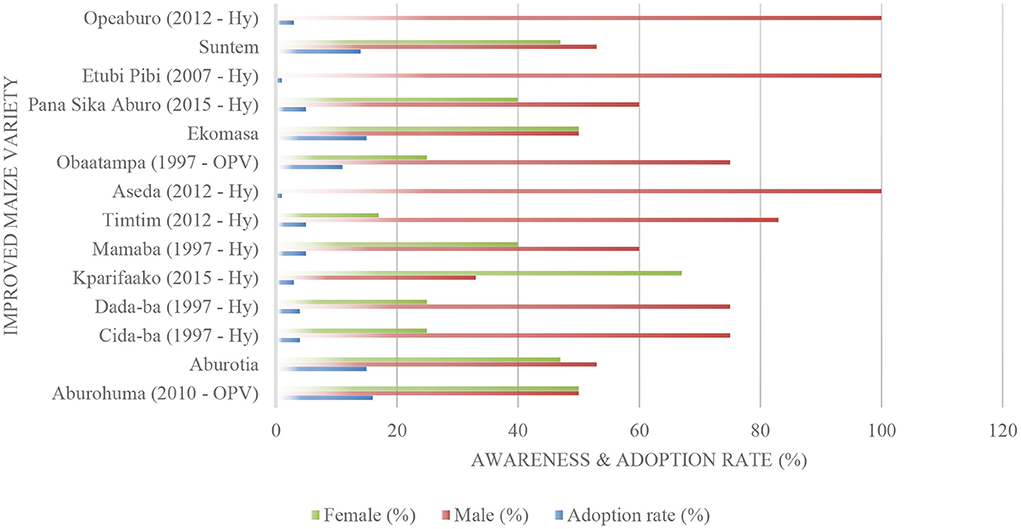
Figure 3. Distribution showing improved maize variety and adoption rate per gender. Hy, Hybrid; OPV, Open Pollinated Varieties. This figure compares the overall adoption rate of improved seeds with the adoption rate of male and female. Author, 2021.
In sharp contrast to this suggestion, an agriculture extension officer noted, “farmers are aware of many different maize varieties, but they only show interest to know more about a particular variety they want to adopt.” The study also captured some critical information, such as which gender group, age and level of education of smallholder farmers in the study area are aware of a particularly maize variety. For instance, 67% of female respondents who are aware of hybrid maize such as kparifaako and are adopting it (Figure 3) belong to the category of those with a higher education level (Figure 4) and are also between the ages of 31–40 yrs (Figure 5). In contrast, 53% of males adopting traditional seeds such as Aburotia (Figure 3) belong to the category of those who neither complete primary education nor have only primary education (Figure 4) and are between the ages of 31–40 yrs (Figure 5). This shows that female farmers with higher education levels are more likely to adopt improved maize seeds than their male counterparts.
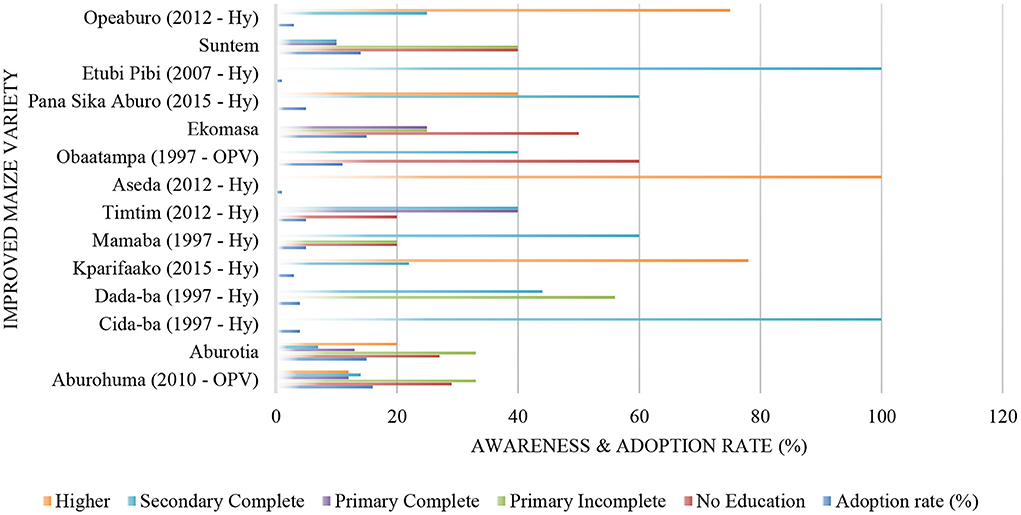
Figure 4. Distribution showing improved maize variety and adoption rate per level of education. Hy, Hybrid; OPV, Open Pollinated Varieties. This figure compares the overall adoption rate with the adoption rate of respondents who belongs to a particular education level category. Author, 2021.
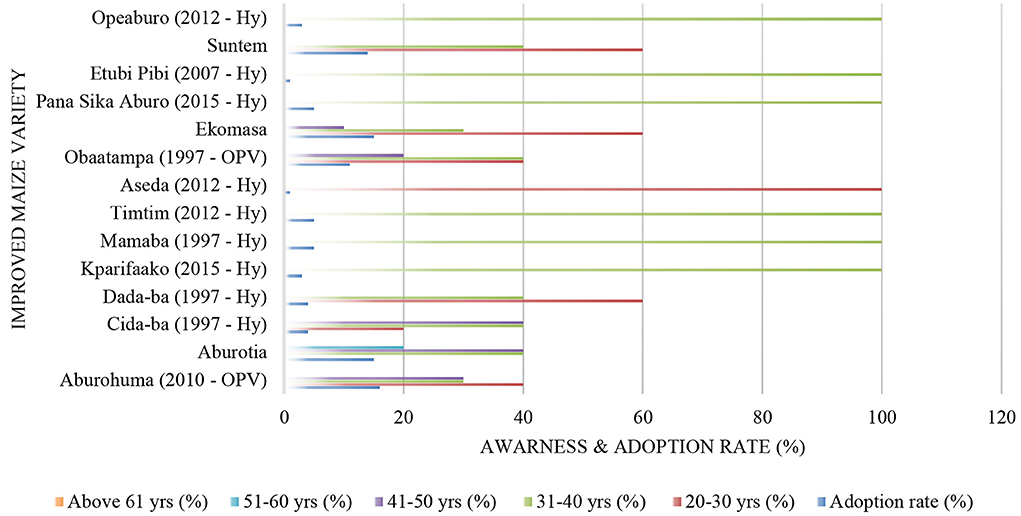
Figure 5. Distribution showing improved maize variety and adoption rate per age group. Hy, Hybrid; OPV, Open Pollinated Varieties. Figure 6 compares the overall adoption rate of improved seeds with the adoption rate of respondents belonging to different age group categories. Author, 2021.
Adoption rate of improved seeds and planting technologies
The study noted adoption rate of improved seeds and their complementary technologies is low (Table 4). The study indicated that only 8% of the respondent use other agrochemicals for weeds and pest control; most of whom (totaling 79%) are between the ages of 31–40 yrs (Table 4). A follow-up question on how long they have been adopting particular seeds and technologies shows that 34% of these farmers have been adopting whatever planting materials they have been introduced to for more than 3 years (Figure 6). From Figure 6, we noticed that out of the 34% of these farmers who have been adopting improved technologies for more than 3 yrs, 81% are male with no school education, or at best have only secondary school education and are between the ages of 31–40 yrs (Figure 6). In contrast, 22% of females have adopted improved maize since the last planting season, out of which 77% have high education and are between the ages of 31–40 yrs (Figure 6). This unique finding, again, confirms that educated female farmers are more willing to adopt improved technologies than their male counterparts. The study noted that male-headed households cultivate maize on an average farm-size of 3.33 ha, while Female-headed households cultivate maize on an average farm-size of 2.33 ha. This phenomenon highlights existing gender disparities in access to land resources to adopt improved seeds and technologies.
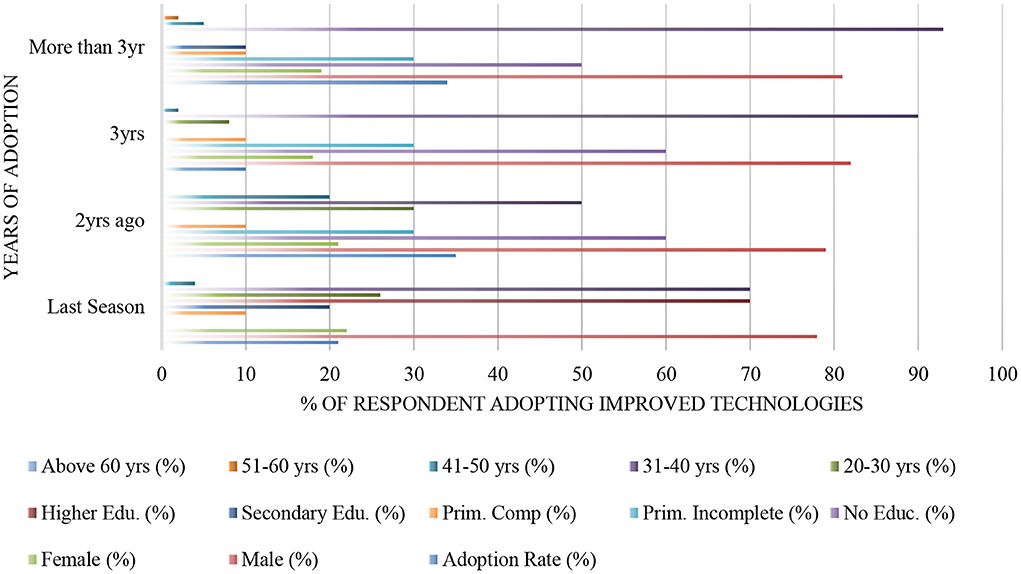
Figure 6. Distribution showing respondent year(s) of adoption of improved technologies. Hy, Hybrid; OPV, Open Pollinated Varieties. This figure compares the overall adoption rate of improved technologies with the number of years respondents have been adopting technologies, their age category, level of education and gender. Author, 2021.
Logistics regression model for improved technologies adoption
This section presents the results of the logistic regression estimates. Model goodness-of-fit tests and model implications are presented in Tables 5, 6 for the technology adoption. In addition, the discussions focus on the model coefficients, Wald test, significance level, odd ratio [exp (b)] and marginal probabilities. From Table 5 above, Wald tests show that ten factors are significant in explaining the adoption of the five different types of improved technologies. Overall, the estimated model has strong explanatory power, as the included variables correctly predict 93.64% of the observations. The model chi-square of 89.40 has a p-value of 0.0000001 [df = 15]. This shows that the overall fit of the model is significant and that variables in the model were useful in explaining improved technology adoption. The determinant of technology adoption is farmers' age, gender, cost of improved seeds, yield potential, market availability for produce, distance to access seeds, complexity and labor requirement in using seeds, readily available farmer-saved seeds, agro-input dealers' influence, and culinary taste.
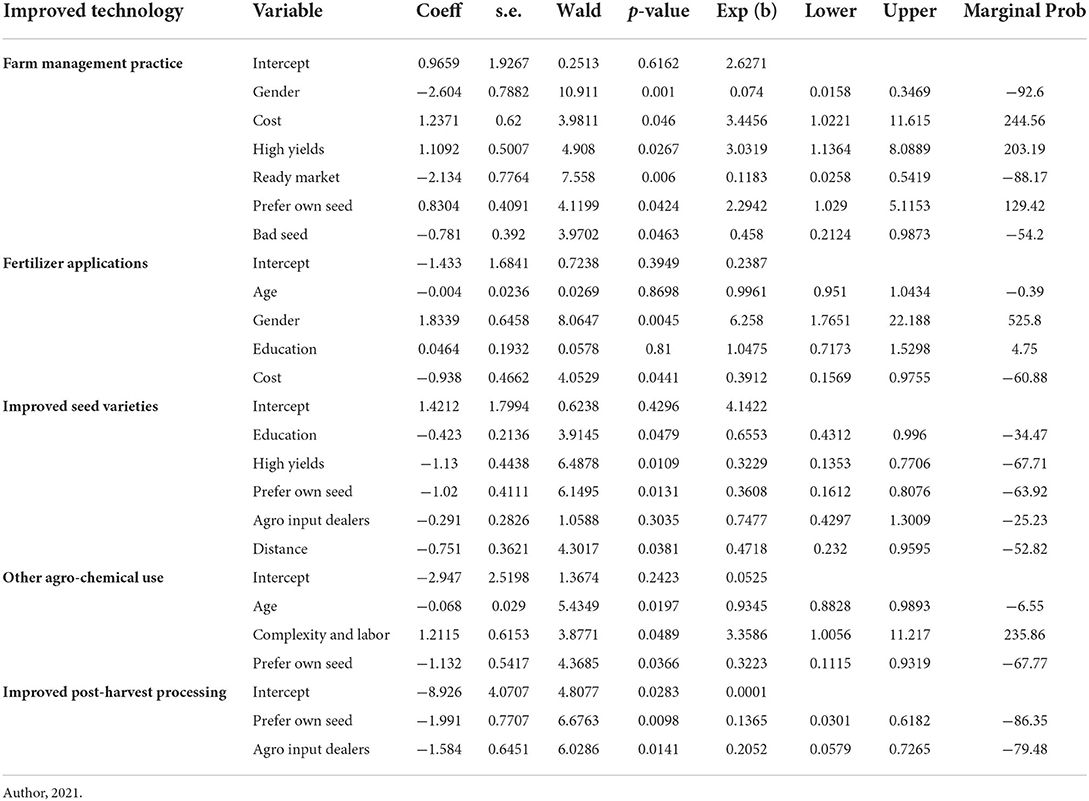
Table 6. Aggregated summary of table of logistic results for different types of improved technologies.
Farmers' exposure to education will increase their ability to access and apply relevant information to the adoption of improved technologies. However, 37% of the farmers had no education, and 26% did not complete primary school-level education. Also, most farming technologies do not heavily depend on educational qualities; therefore, their adoption is not likely to be positively correlated with education. This negatively affected the adoption rate; hence education was insignificant (p-value 0.345) in adopting improved planting technologies.
From Figure 7, the positive variance computation on fertilizer and other agro-chemical applications for female respondents indicates that females adopt these practices more than their male counterparts. Likewise, the variance computation results in Figure 7 also show that male has the potential to adopt improved post-harvest storage and improved post-harvest processing, somewhat similar to their female counterparts. Furthermore, from Figure 8, the positive variance computation for improved post-harvest processing, improved post-harvest storage, and improved seeds varieties among those with primary education indicates that these groups of people tend to adopt these practices compared to other improved agriculture practices such as fertilizer application, other agro-chemical use and farm management practices. Likewise, a positive variance computation on all improved planting technologies for respondents with secondary and high-level education (Figure 8) shows that these persons tend to adopt all six improved planting technologies. Finally, from Figure 9, the positive variance result computed for all improved technologies for respondents between the ages of 50-−80 indicates that these people have the potential to adopt all six planting technologies over any other age group. Likewise, the variance computation result also suggests that young farmers below 30 years tend to adopt all six planting technologies more than those between the ages of 31–50 years (see Figure 9).
Factors influencing the adoption of improved maize seeds and associated technologies
The third objective of the research was to assess the factors that determine the adoption of improved maize seeds and associated technologies by smallholder farmers. The constraints are the availability of the improved seeds, the distance to access them, cost of the improved seeds, yield potential of the seed, ready market for grain, influence of agro-input dealer relative/neighbours of farmers and among others are issues that stand out tall among the factors that enhance adoption of a particular maize variety. These findings were also confirmed through the focus group discussion when farmers were asked to prioritize the five significant factors that constrain their effort to adopt improved seeds and technologies. These farmers mentioned that “Affordability, Yield-ability, Marketability, Availability and Accessibility of improved seeds are critical to influencing the decision to adopt hybrid seeds and complementing technologies.” The study noted that farmers adopting hybrid maize seeds find it helpful in yield potential and ability to withstand various climatic stressors, but it requires colossal farm investment. Most often, the return on investment is slow.
For instance, the study noted a kilogram of Kparifaako (hybrid) is ~US$2.69, whereas that of Aburohuma and Obatampa (OPVs) is about US$0.84 in the open market. Surprisingly the cost of hybrid maize seeds supplied by the government's PFJ initiative is ~US$5.88 per kilogram. The finding suggests that smallholder farmers would require to invest up to seven times more to adopt hybrid seeds than OPVs. These findings were also in agreement with the key informants' response to the adoption of improved maize seeds. Tables 2, 3 show the logistics regression estimate that predicts technology adoption determinants obtained through the household survey.
Discussion
The study shows that despite efforts to ensure farmers adopt improved seeds, maize hybrids' awareness and complementary technologies are low in the study communities. The survey results show that most farmers plant whatever maize seeds are available and accessible to them, with about 71% of farmers currently doing so for over 2 years and above. These findings agree with existing literature (e.g., see: Monela, 2014; Mngoli et al., 2015; Atilaw et al., 2016) that suggests farmers prefer traditional seeds or saved seeds from the previous harvest. Such trends might be difficult to change if there are no social safety programs to incentivize smallholders to adopt improved seeds and technologies. This is because most of these farmers lose income due to their inability to get their stocks to market due to market disruption by the COVID-19 lockdown restriction (Reuters, 2020). Hence, they wouldn't have enough capital to invest in hybrid seeds and technologies. This situation is critical because smallholder farmers would have to pay three to seven times more to purchase a kilogram of hybrid maize seeds than OPVs in the open market. This situation could exacerbate indebtedness and livelihood crises of smallholder farmers adopting improved seeds and technologies, as suggested by Moseley et al. (2015) and Vercillo et al. (2020).
The study also shows a significant relationship between a farmer's age and improved technologies' adoption rate. For instance, farmers above 50 years old adopt improved technologies more than young farmers because they are more exposed to these technologies and can cope with uncertainty and risk than younger farmers. Likewise, farmers below 30 years are more likely to adopt improved planting technologies than those between 31 and 50 years. This finding supports the long-standing argument that farmers' age is significant to technology adoption for agricultural productivity. In contrast, Adeogun et al. (2010) argued that young farmers are more willing to search for information on new technologies for adoption than old farmers. The study also disputes the findings of a large body of literature (e.g., see: Green and Ng'ong‘ola, 1993; Baidu-Forson, 1999; Boahene et al., 1999), all of which argue that age is of no significance when it comes to the adoption of improved technologies.
Furthermore, the study demonstrated a strong relationship between gender and the adoption of improved maize seeds and their complementary technologies. This contradicts Doss and Morris's (2001) argument that the adoption of improved maize technology gender of the farmers has no significance on the adoption rate in Ghana. The research illustrates another point of departure from the literature. In particular, previous studies by Ehler and Bottrell (2000) and Caswell et al. (2001) suggested farmers' education level is critical to technology adoption due to complexities associated with adopting improved seeds. The study noted farmers' enduring intensification dilemma to adopt or not adopt improved technologies, as indicated by Quarshie and Abdulai (2021), accounted for this situation. However, we can suggest from this study that educated female farmers are more willing to adopt improved technologies than their male counterparts.
The study results indicate that females with higher education levels adopt fertilizer and other agrochemical applications more often than their male counterparts. However, males adopt post-harvest processing and storage like their female counterparts. This particular finding, which is in sharp contrast with what is typically observed on the field, may be attributed to a division of labor within each farmer's household's family settings. Male farmers are involved in land preparation and ploughing, whiles females either do the fertilizer and other agro-chemical applications or supervise any person hired to do this task on the farm. Secondly, commercial farmers and seed producers hire female farmers' services to harvest, sort, and clean their grains during the harvest season. This situation leaves the male farmers with the option of undertaking post-harvest processing and storage of grains while their spouses or female farmers work to make extra income to support the family.
Furthermore, the study result highlighted that male farmers with a ‘primary complete' level of education are less likely to adopt fertilizer application, other agro-chemical use and improved farm management practices compared to other technologies such as improved post-harvest processing, improved post-harvest storage and improved seeds varieties. This situation has been attributed to the high cost of agriculture inputs and male farmers' engagement in livelihood diversification activities by selling their labor on other people's farms.
Furthermore, the survey pointed out that the factors that enhance or militate against the adoption of improved seeds and their complementary technologies are multifaceted and intertwined, enmeshed within demographic characteristics, socioeconomic and socio-cultural constraints. The chiefest among them are; distance to access improved seeds, the cost of improved seeds, yield level of seeds, market access, and the maturity period of the crop. Improved seeds with early maturity characteristics are essential to these farmers because the majority of the smallholders cultivate maize under rainfed and are at the mercy of climate perturbation, which has affected rainfall patterns in SSA in recent times. The study shows that the complexity and labor requirement, the availability and accessibility of the improved seeds, and agro-dealers role in ensuring effective delivery of quality seeds and their complementary technologies to smallholder farmers influence smallholders' decision to adopt improved technologies for planting. Finally, other social-cultural factors like the taste of food produced from grain and influence from social networks play a crucial role in farmers' decision to adopt improved technologies as these farmers are bonded together by their customs (Nyantakyi-Frimpong and Bezner Kerr, 2015; Kansanga et al., 2018) and take advise from their colleagues.
Results interpretation with theories on technology adoption
From the study result, we can understand how these three theories; Rogers innovation diffusion theory, induced innovation theory, and failed market induce- behavior, all give us a deeper understanding of the determinants of technology adoption rate. For instance, the level of awareness of improved seeds among smallholders culminating in the adoption rate is a classic example of how Dosi (1992) expounded on Rogers's theory of innovation diffusion. This finding implies that the more farmers are aware of improved seeds and technologies, the more they are likely to adopt them. Likewise, we notice cost improved seeds, comparative advantages of hybrid seeds over other seeds such as their yield potential and early maturity characteristics point to how Rogers (2003) explains factors that enhance the adoption rate of technologies. Furthermore, the poor adoption rate of hybrid seeds such as Kparifaako could be identified with failed market induced-behavior among smallholders. This is because the Ghana Government's PFJ program, which aims to enhance farmers' access to improved seeds, technologies and extension services, is selling a kilogram of Kparifaako hybrid seeds at the cost of US$5.88. In contrast, a kilogram of the same seeds is sold at US$2.69 on the open market. The tendency for smallholders to buy bad seeds in the open market (which is also a determinant of improved maize seeds adoption) and the high cost of the government “quality” seeds interplay to lower the adoption rate of hybrid seeds. Likewise, we notice market entities such as agro-input dealers and available farm produce markets enhance the adoption rate of improved seeds. Their absence can influence farmers' decisions not to adopt improved technologies. Finally, the yield potential of improved maize seeds, age of farmers, level of education among different respondents' groups, and gender differentials are all pointers to how Just et al. (1979), Ruttan and Hayami (1984) and Doss (2013) explain are the factors that enhance adoption of technologies under the induced-innovation theory.
Policy focus and recommendations
Our results show there is a good general awareness of maize varieties and their complementary technologies among farmers in Ghana. However, such awareness is mainly on the old varieties of improved maize seeds and not more recent productive varieties, adaptable to their specific geographic areas like Kparifaako, Etubi Pibi, Aseda, Opeaburoo and Tintim. The adoption rate of improved seeds—hybrid maize and its complementary technologies is still very low among farmers in the study communities. Some farmers even consider certain maize grains that are traditional or farmer-seeded seeds as improved maize seeds. We proposed that social intervention programs such as input subsidy programs should be strengthened to deliver hybrid seeds to farmers to achieve widespread adoption of hybrid seeds and complementing technologies. Efforts must be made to ensure only quality seeds get into farmers' hands. Recently, farmers have lost confidence in improved seeds supplied under the Ghana government's PFJ program, citing issues of bad seeds and poor germination (Ghanaweb, 2020).
It is also essential that the government in SSA work with credit and financial institutions to give credit breaks to debt-ridden farmers and enhance smallholders' access to credits for investment in agricultural inputs such as improved seeds, fertilizer application, and other purchases productivity in their quest to adopt improved technologies. There is also the need for rural farmers' capacity to be built to adopt hybrid seeds and technologies through rigorous location and context-specific-targeted extension services delivery. For instance, if farmers between the ages of 50 and 80 with a higher education level turn to adopt all improved planting technologies than younger generation farmers, then young educated farmers should be targeted with information about why they need to adopt hybrid seeds and technologies and train them to be able to apply these technologies. For example, if females with higher education levels are adopting fertilizer and other agrochemical applications more often than their male counterparts, then the male farmers need capacity building in that respect to create synergy-wide-scale improved technology adoption to increase productivity. Any capacity building targeting women smallholders in this regard is essential and supports the argument that “the adoption of agricultural technology by women is particularly important as it can generate large gains in alleviating poverty” (Rola-Rubzen et al. 2020, pp.114). Furthermore, child survival, nutrition and health are noted to be better when women have access to modern agricultural technologies compared to men, according to Agarwal (2013, 2018).
Extension delivery could be done through channels such as mobile voice messages in the local dialect and info-graphic branded seed packets. It is imperative to mention that policy effort that neglects the critical role of female farmers and women-headed households in terms of food production and caregivers of the sick throughout this pandemic (Moseley and Battersby, 2020) and beyond will undermine the region's food production efforts. Efforts must be made to support their uptake of improved technologies for enhanced productivity. There is a need to incorporate local knowledge and values in deploying these technologies (Nyantakyi-Frimpong and Bezner Kerr, 2015; Kansanga et al., 2018) to avoid eroding cultural identities and smallholder farmers' sense of place in communities where improved technologies are being scaled up.
Conclusion
Based on this research's findings, we could conclude that there is a good general awareness of maize varieties and their complementary technologies among smallholder farmers in Ghana. However, such awareness is mainly on the old varieties of improved maize seeds and not more recent productive varieties, adaptable to their specific geographic areas like Kparifaako, Etubi Pibi, Aseda, Opeaburoo and Tintim. The adoption rate of improved seeds—hybrid maize and its complementary technologies is still very low among farmers. Some farmers even consider certain maize grains that are traditional or farmer-seeded seeds as improved maize seeds. Such trends and farmer behavior only lead to unsustainable and low agricultural productivity, which frustrates Ghana Government's effort to increase food production to reduce the current food import bill. The findings reveal socio-demographic and economic factors such as age, gender, cost of seeds, the promise of more yields, market access, social networks' influence, seeds availability and accessibility are essential determinants of adopting improved planting technologies. Given that most nations in the region are yet to recover from COVID-19 induced economic recession, we argue that strong government efforts are required to accelerate policy reforms and extension services that address location and context-specific adoption challenges within different farming settings. This is essential to enhance the wide-scale adoption of improved seeds and technologies to increase agricultural productivity, achieve food security and improve rural household economic wellbeing post-COVID 19 pandemic.
Data availability statement
The datasets presented in this study can be found in online repositories. The names of the repository/repositories and accession number(s) can be found below: https://www.frontiersin.org/articles/10.3389/fsufs.2021.665297/full#supplementary-material.
Ethics statement
All research was conducted in a manner that does not jeopardize respondents physically, mentally, and socially according to the Ghana Institute of Management and Public Administration students' research guidelines and the University of Guelph. Written informed consent was sought from every participant before the survey and interview were conducted.
Author contributions
PQ drafted the first copy of the manuscript and the rest of the co-authors incorporated their input. All authors contributed to the article and approved the submitted version.
Funding
PQ receives funding from the Canada First Research Excellence Fund (Food from Thought 499077) and the Canada Research Chairs Program.
Conflict of interest
Author PQ was employed by Global Agri-Business Solutions INC.
The remaining authors declare that the research was conducted in the absence of any commercial or financial relationships that could be construed as a potential conflict of interest.
Publisher's note
All claims expressed in this article are solely those of the authors and do not necessarily represent those of their affiliated organizations, or those of the publisher, the editors and the reviewers. Any product that may be evaluated in this article, or claim that may be made by its manufacturer, is not guaranteed or endorsed by the publisher.
Supplementary material
The Supplementary Material for this article can be found online at: https://www.frontiersin.org/articles/10.3389/fsufs.2022.804984/full#supplementary-material
References
Abate, T., Fisher, M., Abdoulaye, T., Kassie, G. T., Lunduka, R., Marenya, P., et al. (2017). Characteristics of maize cultivars in Africa: how modern are they and how many do smallholder farmers grow? Agricult. Food Secur. 6, 30. doi: 10.1186/s40066-017-0108-6
Abdoulaye, T., Wossen, T., and Awotide, B. (2018). Impacts of improved maize varieties in Nigeria: ex-post assessment of productivity and welfare outcomes. Food Secur. 10, 369–379. doi: 10.1007/s12571-018-0772-9
Adeogun, S. O., Olawoye, J. E., and Akinbile, L. A. (2010). Information sources to cocoa farmers on cocoa rehabilitation techniques (CRTs) in selected states of Nigeria. Media and Communication Studies, 9–15.
Adesina, A. A., and Baidu-Forson, J. (1995). Farmers' perceptions and adoption of new agricultural technology: evidence from analysis in Burkina Faso and Guinea, West Africa. Agricult. Econ. Vol. 13, 1–10. doi: 10.1111/j.1574-0862.1995.tb00366.x
Afful-Koomson, T., Fonta, W., Frimpong, S., and Amoh, N. (2015). Economic and Financial Analyses of Small and Medium Food Crops Agro-Processing Firms in Ghana. Accra: United Nations University Institute for Natural Resources in Africa (UNU-INRA), Ghana.
Agarwal, B. (2013). Food Security, Productivity, and Gender Inequality (R. J. Herring, Ed.; Vol. 1). Oxford: Oxford University Press.
Agarwal, B. (2018). Gender equality, food security and the sustainable development goals. Curr. Opin. Environ. Sustain. 34, 26–32. doi: 10.1016/j.cosust.2018.07.002
Ainissyifa, H., Wulan, E. R., Muhyiddin, A., and Ramdhani, M. A. (2018). Innovation and technology diffusion in agricultural sector.
Alliance for a Green Revolution in Africa (AGRA) (2018). AGRA Fact Sheet. Nairobi, Kenya: Alliance for a Green Revolution in Africa (AGRA).
Amadu, F. O., McNamara, P. E., and Miller, D. C. (2020). Understanding the adoption of climate-smart agriculture: a farm-level typology with empirical evidence from southern Malawi. World Develop. 126, 104692. doi: 10.1016/j.worlddev.2019.104692
Antwi-Agyei, P., Quinn, C. H., Adiku, S. G. K., Codjoe, S. N. A., Dougill, A. J., Lamboll, R., et al. (2017). Perceived stressors of climate vulnerability across scales in the Savannah zone of Ghana: A participatory approach. Reg. Environ. Change 17, 213–227. doi: 10.1007/s10113-016-0993-4
Araya, Y., Dorward, A., Gideon, J., Kock, R., Smith, L., and Waage, J. (2015). “Agriculture and food,” in London International Development Centre (LIDC), J. Waage, C. Yap, and London International Development Centre (LIDC) (Eds.), Thinking Beyond Sectors for Sustainable Development (London: Ubiquity Press), pp. 45–50.
Asante, B. O., Koomson, I., Villano, R. A., and Wiredu, A. N. (2021). Adoption of integrated crop-livestock management practices (ICLMPs) among men and women smallholder farmers in Ghana. Gender Technol. Develop. 25, 163–192, doi: 10.1080/09718524.2021.1911021
Asante, B. O., Villano, R. A., and Battese, G. E. (2014). The effect of the adoption of yam minisett technology on the technical efficiency of yam farmers in the forest-savanna transition zone of Ghana. Afric. J. Agricult. Resour. Econ. 9, 75–90.
Atilaw, A., Alemu, D., Bishaw, Z., Kifle, T., and Kaske, K. (2016). Early generation seed production and supply in Ethiopia: Status, challenges and opportunities. Ethiop. J. Agric. Sci. 27, 99–119.
Ayanlade, A., and Radeny, M. (2020). COVID-19 and food security in Sub-Saharan Africa: implications of lockdown during agricultural planting seasons. Npj Sci. Food 4, 13. doi: 10.1038/s41538-020-00073-0
Azinu, A. R. (2014). Evaluation Of Hybrid Maize Varieties In Three Agroecological Zones In Ghana. Accra: University of Ghana.
Baidu-Forson, J. (1999). Factors influencing adoption of land-enhancing technology in the Sahel: lessons from a case study in Niger. Agricult. Econ. 20, 231–239. doi: 10.1016/S0169-5150(99)00009-2
Bloomberg Market (2017). Retrieved from Bloomberg Market. Available online at: https://www.bloomberg.com/news/articles/2017-11-13/ghana-to-cut-2-2-billion-bill-with-farm-support-president-says (accessed November 23, 2017).
Boahene, K., Snijders, T. A., and Folmer, H. (1999). An integrated socioeconomic analysis of innovation adoption: the case of hybrid cocoa in Ghana. Policy Model. 21, 167–184. doi: 10.1016/S0161-8938(97)00070-7
Buah, S. S. J., Nutsugah, S. K., Kanton, R. A. L., Atokple, I. D. K., Dogbe, W., Karikari, A. S., et al. (2011). Enhancing farmers' access to technology for increased rice productivity in Ghana. Afr. J. Agri. Res. 6, 4455–4466. doi: 10.5897/AJAR11.1152
Caswell, M., Fuglie, K. O., Ingram, C., Jans, S., and Kascak, C. (2001). Adoption of Agricultural Production Practices: Lessons Learned From the US Department of Agriculture Area Studies Project (No. 1473-2016-120785). Available online at: https://www.ers.usda.gov/webdocs/publications/41192/32131_aer792.pdf?v=8538
Cavane, E., and Donovan, C. (2011). Determinants of adoption of improved maize varieties and chemical fertilizers in Mozambique. J. Int. Agricult. Exten. Educ. 18, 3. doi: 10.5191/jiaee.2011.18301
CIMMYT (2020). Seeds of Discovery (SeeD). CIMMYT. Available online at: https://www.cimmyt.org/projects/seeds-of-discovery-seed/ (accessed September 13, 2022).
Croppenstedt, A., Goldstein, M., and Rosas, N. (2013). Gender and agriculture: inefficiencies, segregation, and low productivity traps. World Bank Res. Observ. 28, 1–31. doi: 10.1093/wbro/lks024
De Janvry, A., and Sadoulet, E. (2006). Making conditional cash transfer programs more efficient: designing for maximum effect of the conditionality. World Bank Econom. Rev. 20, 1–29. Available onlune at: https://www.jstor.org/stable/40282317
Dixon, J., Gulliver, A., and Gibbon, D. (2001). Farming Systems and Poverty; Improving Farmers Livelihoods in a Changing world. Rome and Washington DC: FAO and World Bank.
Dontsop Nguezet, P. M., Diagne, A., Okoruwa, O. V., Ojehomon, V., and Manyong, V. (2013). Estimating the actual and potential adoption rates and determinants of NERICA rice varieties in Nigeria. J. Crop Improve. 27, 561–585. doi: 10.1080/15427528.2013.811709
Dosi, G. (1992). The research on innovation diffusion. some introductory remarks. Rivista Internazionale Di Scienze Sociali 100, 219–226.
Doss, C. (2013). Intrahousehold bargaining and resource allocation in developing countries. The World Bank Res. Observ. 28, 52–78. doi: 10.1596/1813-9450-6337
Doss, C. R., and Morris, M. L. (2001). How does gender affect the adoption of agricultural innovations? the case of improved maize technology in Ghana. Agricult. Econ. 1, 27–39. doi: 10.1016/S0169-5150(00)00096-7
Ehler, L. E., and Bottrell, D. G. (2000). The illusion of integrated pest management. Issues Sci. Technol. 16, 61–64.
FAO (2014). Food and Agricultural Organization of the United Nation. Available online at: http://www.fao.org/3/a-at535e.pdf, (accessed September 25, 2014).
FAO (2017). www.fao.org. Retrieved from Food and Agriculture Organisation. Available online at: http://www.fao.org/agriculture/crops/thematic-sitemap/theme/seeds-pgr/seed-sys/en/ (accessed November 10, 2017).
FAO (2020). Social Protection and COVID-19 Response in Rural Areas. Policy brief. Available online at: http://www.fao.org/3/ca8561en/CA8561EN.pdf (accessed September 13, 2022).
Foley, J. A., Ramankutty, N., Brauman, K. A., Cassidy, E. S., Gerber, J. S., Johnston, M., et al. (2011). Solutions for a cultivated planet. Nature 478, 337–342. doi: 10.1038/nature10452
Gakpo, J. O. (2020). “Africa looks to build food self-sufficiency as COVID disrupts global supply chain.” Cornell Alliance for Science. Available online at: https://allianceforscience.cornell.edu/blog/2020/05/africa-looks-to-build-food-self-sufficiency-as-covid-disrupts-global-supply-chain/ (accessed May 1, 2020).
Gao, L., Zhang, W., Mei, Y., Sam, A. G., Song, Y., and Jin, S. (2018). Do farmers adopt fewer conservation practices on rented land? evidence from straw retention in China. Land Use Policy 79, 609–621. doi: 10.1016/j.landusepol.2018.08.026
Garrity, D., Dixon, J., and Boffa, J.-M. (2017). “Understanding African farming system as a basis for sustainable intensification,” in Sustainable Intensification in Smallholder Agriculture: An Integrated Systems Research Approach (London: Routledge).
Gassner, A., Harris, D., Mausch, K., Terheggen, A., Lopes, C., Finlayson, R., et al. (2019). Poverty eradication and food security through agriculture in Africa: rethinking objectives and entry points. Outlook Agricult. 48, 309–315. doi: 10.1177/0030727019888513
Gebre, G. G., Isoda, H., Rahut, D. B., Amekawa, Y., and Nomura, H. (2019). Gender differences in the adoption of agricultural technology: The case of improved maize varieties in southern Ethiopia. Women's Stud. Int. Forum 76, 102264. doi: 10.1016/j.wsif.2019.102264
Ghana National Daily Graphic (2018). Graphic Business. Available online at: https://www.graphic.com.gh/business/business-news/food-imports-cost-us-2-4bn-annually.html (accessed September 13, 2022).
Ghana Statistical Services (GSS) (2014). 2010 Population and Housing Census. Accra: Ghana Statistics Services.
Ghanaweb (2020). Farmers' trust in improved seeds fell in 2019—Research. Ghanaweb. Available online at: https://www.ghanaweb.com/GhanaHomePage/business/Farmers-trust-in-improved-seeds-fell-in-2019-Research-1138829 (accessed December 22, 2020).
Gichuki, C. N., and Mulu-Mutuku, M. (2018). Determinants of awareness and adoption of mobile money technologies: Evidence from women micro entrepreneurs in Kenya. Women's Stud. Int. Forum. 67, 18–22. doi: 10.1016/j.wsif.2017.11.013
Green, D. A., and Ng'ong‘ola, D. H. (1993). Factors Affecting fertilizer adoption in less developed countries: an application of multivariate logistic analysis In Malawi. Agricult. Econ. 1, 99–109. doi: 10.1111/j.1477-9552.1993.tb00253.x
Just, R. E., Schmitz, A., and Zilberman, D. (1979). Technological change in agriculture. Science 206, 1277–1280. doi: 10.1126/science.206.4424.1277
Kansanga, M., Andersen, P., Kpienbaareh, D., Mason-Renton, S., Atuoye, K., Sano, Y., et al. (2018). Traditional agriculture in transition: examining the impacts of agricultural modernization on smallholder farming in ghana under the new green revolution. Int. J. Sustain. Develop. World Ecol. 26, 11–24. doi: 10.1080/13504509.2018.1491429
KC, K. B., Legwegoh, A. F., Therien, A., Fraser, E. D., and Antwi-Agyei, P. (2018). Food price, food security and dietary diversity: a comparative study of Urban Cameroon and Ghana. J. Int. Develop. 30, 42–60. doi: 10.1002/jid.3291
Krejcie, R. V., and Morgan, D. W. (1970). Determining sample size for research activities. Educ. Psychol. Measure. 30, 607–610.
Kutka, F. (2011). Open-Pollinated vs. hybrid maize cultivars. Sustainability 3, 1531–1554. doi: 10.3390/su3091531
Langyintuo, A., Mwangi, W., Diallo, A., Macrobert, J., Dixon, J., and Bänziger, M. (2010). Challenges of the maize seed industry in eastern and southern Africa: A compelling case for private–public intervention to promote growth. Food Policy 35, 323–331. doi: 10.1016/j.foodpol.2010.01.005
Martey, E., Etwire, P. M., and Abdoulaye, T. (2020). Welfare impacts of climate-smart agriculture in Ghana: does row planting and drought-tolerant maize varieties matter? Land Use Policy. 95, 104622. doi: 10.1016/j.landusepol.2020.104622
Mausch, K., Harris, D., Heather, E., Jones, E., Yim, J., and Hauser, M. (2018). Households' aspirations for rural development through agriculture. Outlook Agricult. 47, 108–115. doi: 10.1177/0030727018766940
Mignouna, D. B., Manyong, V. M., Rusike, J., Mutabazi, K. D. S., and Senkondo, E. M. (2011). Determinants of adopting Imazapyr-resistant maize technologies and its Impact of household Income in Western Kenya. Ag. Bio. Forum. 14, 158–163.
Mngoli, M. B., Mkwambisi, D. D., and Fraser, E. D. (2015). An evaluation of traditional seed conservation methods in Rural Malawi. J. Int. Develop. 27, 85–98. doi: 10.1002/jid.3052
MoFA–Statistics Research and Information Directorate (SRID). (2016). Fact and Figures. Accra: Ministry of Food and Agriculture.
Monela, A. G. (2014). Access To And Adoption Of Improved Seeds By Smallholder Farmers In Tanzania: Cases Of Maize And Rice Seeds In Mbeya And Morogoro Regions. Morongoro: Monela, Anna Gerald.
Moseley, W., Schnurr, M., and Bezner Kerr, R. (2015). Interrogating the technocratic (neoliberal) agenda for agricultural development and hunger alleviation in Africa. Afric. Geographic. Rev. 34, 1–7. doi: 10.1080/19376812.2014.1003308
Moseley, W. G., and Battersby, J. (2020). The vulnerability and resilience of african food systems, food security, and nutrition in the context of the COVID-19 pandemic. Afric. Stud. Rev. 63, 449–461. doi: 10.1017/asr.2020.72
Muzari, W., Gatsi, W., and Muvhunzi, S. (2012). The impacts of technology adoption on smallholder agricultural productivity in Sub-Saharan Africa: a review. J. Sustain. Develop. 5, 8. doi: 10.5539/jsd.v5n8p69
Ndiritu, S. W., Kassie, M., and Shiferaw, B. (2014). Are there systematic gender differences in the adoption of sustainable agricultural intensification practices? Evidence from Kenya. Food Policy, 49, 117–127. doi: 10.1016/j.foodpol.2014.06.010
Nyantakyi-Frimpong, H., and Bezner Kerr, R. (2015). A political ecology of high-input agriculture in northern Ghana. Afric. Geographic. Rev. 34, 13–35. doi: 10.1080/19376812.2014.929971
Ogada, M. J., Mwabu, G., and Muchai, D. (2014). Farm technology adoption in Kenya: a simultaneous estimation of inorganic fertilizer and improved maize variety adoption decisions. Agricult. Food Econ. 2, 1–18. doi: 10.1186/s40100-014-0012-3
Ojiewo, C. O., and Pillandi, R. (2020). These Seeds Could Prevent a COVID-19 Food Crisis in Africa [World Economic Forum]. World Economic Forum. Available online at: https://www.weforum.org/agenda/2020/06/africa-food-crisis-covid-19-seed-revolution/ (accessed September 13, 2022).
Peterman, A., Julia, B., and Agnes, Q. (2010). “A review of empirical evidence on gender differences in non-land agricultural inputs, technology, and services in developing countries,” International Food Policy Research Institute (IFPRI).
Preneuf, F. (2020). Food Security and COVID-19. World Bank. Available online at: https://www.worldbank.org/en/topic/agriculture/brief/food-security-and-covid-19 (accessed January 21, 2021).
Quarshie, P., and Abdulai, A.-R. (2021). The Enduring Intensification Dilemma of Africa's Rural Farmer.pdf [USAID FtF Project]. AGRILINKS.
Quarshie, P., Tetteh, A-R., Abdulai, T., and Fraser, D. G. (2021). Africa's 'Seed' Green Revolution and the value chain constraint to Early Generation Seeds Commercialization and Adoption in Ghana.
Quarshie, P. T. (2021). Exploring the concept of place in the literature on smallholder farmers and climate change adaptation in Sub-Saharan Africa, South African. Geographic. J. 1, 9. doi: 10.31235/osf.io/6tvm9
Ragasa, C. (2012). Gender and institutional dimensions of agricultural technology adoption: A review of literature and synthesis of 35 case studies [Poster presentation]. Foz do Iguacu: International Association of Agricultural Economists (IAAE) Triennial Conference.
Ragasa, C., Dankyi, A., Acheampong, P., Wiredu, A. N., and Chapoto, A. (2013). Patterns of Adoption of Improved Maize Technologies in Ghana. IFPRI working paper, 1–33.
Reuters (2020). Zimbabwe reopens produce markets after protests by drought-hit-farmers. Daily Maverick. Available online at: https://www.dailymaverick.co.za/article/2020-04-09-zimbabwe-reopens-produce-markets-after-protests-by-drought-hitfarmers/#gsc.tab=0 (accessed 20 April 20, 2020).
Rola-Rubzen, M. F., Paris, T., Hawkins, J., and Sapkota, B. (2020). Improving gender participation in agricultural technology adoption in Asia: from rhetoric to practical action. Appl. Econ. Perspect. Policy 42, 113–125. doi: 10.1002/aepp.13011
Rose, S., Spinks, N., and Canhoto, A. I. (2014). Management Research: Applying the Principles (1st ed.). London: Routledge.
Ruttan, V. W., and Hayami, Y. (1984). Toward a theory of induced institutional innovation. J. Develop. Stud. 20, 203–223. doi: 10.1080/00220388408421914
Smale, M., and Mason, N. (2014). Hybrid seed and the economic well-being of smallholder maize farmers in Zambia. J. Develop. Stud. 50, 680–695. doi: 10.1080/00220388.2014.887690
Taherdoost, H. (2017). Determining sample size; how to calculate survey sample size. Int. J. Econom. Manag. Syst. 2, 21.
Tanellari, E., Kostandini, G., Bonabana-Wabbi, J., and Murray, A. (2014). Gender impacts on adoption of new technologies: the case of improved groundnut varieties in Uganda. Afr. J. Agri. Resour. Econom. 9, 300–308.
Teye, E. S., and Quarshie, P. T. (2021): Impact of agricultural finance on technology adoption, agricultural productivity rural household economic wellbeing in Ghana: a case study of rice farmers in Shai-Osudoku District. South Afric. Geographic. J. 21, 2. doi: 10.31235/osf.io/9ue2k
Tsige, M., Synnevåg, G., and Aune, J. B. (2020). Gendered constraints for adopting climate-smart agriculture amongst smallholder Ethiopian women farmers. Scientific Afric. 7, e00250. doi: 10.1016/j.sciaf.2019.e00250
Uaiene, R., Arndt, C., and Masters, W. (2009). Determinants of agricultural technology adoption in Mozambique. Discussion papers No. 67E. Ministry of Planning and Development, Republic of Mozambique, Tete.
Uduji, J. I., and Okolo-Obasi, E. N. (2018). Adoption of improved crop varieties by involving farmers in the e-wallet program in Nigeria. J. Crop Improv. 32, 717–737. doi: 10.1080/15427528.2018.1496216
UN Stats (2021). Retrieved from Goal 2: End hunger, achieve food security and improved nutrition and promote sustainable agriculture—SDG Indicators. Available online at: https://unstats.un.org/sdgs/report/2016/goal-02/ (accessed September 13, 2022).
UN-FAO. (2021). Retrieved from SDG 2. Zero hunger | Sustainable Development Goals | Food and Agriculture Organization of the United Nations. Available online at: http://www.fao.org/sustainable-development-goals/goals/goal-2/en,/ (accessed September 13, 2022).
Keywords: agricultural productivity, food security, improved seeds adoption, smallholder farmers, technologies adoption, Sub-Sahara Africa (SSA), COVID-19
Citation: Quarshie PT, Antwi-Agyei P, Suh NN and Fraser EDG (2022) Tackling post-COVID-19 pandemic food crises through the adoption of improved maize seeds and technologies by smallholder farmers: The case of Ejura Sekyeredumase in Ghana. Front. Sustain. Food Syst. 6:804984. doi: 10.3389/fsufs.2022.804984
Received: 29 October 2021; Accepted: 07 September 2022;
Published: 23 September 2022.
Edited by:
Benjamin Anang, University for Development Studies, GhanaReviewed by:
Jan W. Low, International Potato Centre, KenyaPatrick Nyambo, University of Fort Hare, South Africa
Copyright © 2022 Quarshie, Antwi-Agyei, Suh and Fraser. This is an open-access article distributed under the terms of the Creative Commons Attribution License (CC BY). The use, distribution or reproduction in other forums is permitted, provided the original author(s) and the copyright owner(s) are credited and that the original publication in this journal is cited, in accordance with accepted academic practice. No use, distribution or reproduction is permitted which does not comply with these terms.
*Correspondence: Philip Tetteh Quarshie, cHF1YXJzaGlAdW9ndWVscGguY2E=
 Philip Tetteh Quarshie
Philip Tetteh Quarshie Philip Antwi-Agyei
Philip Antwi-Agyei Neville N. Suh6,7
Neville N. Suh6,7 Evan D. G. Fraser
Evan D. G. Fraser